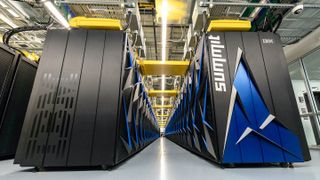US requests proposals for next-gen Discovery supercomputer — will be up to five times faster than the world's fastest supercomputer, arrive in 2027
The more the merrier.

Last week, the Department of Energy (DOE) issued a request for proposals (RFP) to develop a new supercomputer named Discovery. This supercomputer will replace the current known fastest supercomputer in the world, Frontier, at Oak Ridge National Laboratory. Discovery aims to surpass Frontier's performance, offering three to five times more computational throughput (e.g., 8.5 ExaFLOPS) by 2027 or early 2028.
ORNL mentions advanced AI, machine learning, improved energy efficiency, and comprehensive system modeling among the workloads that will run on the Discovery supercomputer. Unlike previous RFPs, this one does not specify an exact performance increase but only says that the new supercomputer has to be three to five times more powerful than its predecessor.
Discovery's computational power will support scientific research in various fields, including AI, climate change, drug discovery, nuclear security, and green energy solutions. Researchers will be able to leverage Discovery’s advanced computational power and capabilities in modeling, simulation, high-performance data analysis, and AI to achieve significant breakthroughs in both scientific and industrial fields. Like Frontier, scholars globally will have the chance to compete for computing time on Discovery to address major scientific challenges.
"Discovery will enable the scientific community to model real-world situations at new levels of detail. It will help us study challenging problems we cannot easily explore with experiment, observation or theory alone," said Georgia Tourassi, ORNL associate laboratory director of computing and computational sciences. "Using Discovery, scientists will improve the safety and efficiency of nuclear power plants and aerospace engineering, pushing the boundaries of what’s possible in sustainable power generation and aviation. They will accelerate the development of new drugs and advanced materials. They will even gain deeper insights in global climate dynamics to inform critical decisions for our collective future."
Proposals for Discovery are due by August 30, 2024.
The ORNL has a history of deploying the world's fastest supercomputers. For example, Jaguar, Titan, and Summit led the world's Top 500 list in different years. Frontier is the world's No. 1 supercomputer today. In fact, over the past decade, the facility has increased its computational power 500-fold while only quadrupling energy consumption.
Stay On the Cutting Edge: Get the Tom's Hardware Newsletter
Get Tom's Hardware's best news and in-depth reviews, straight to your inbox.

Anton Shilov is a contributing writer at Tom’s Hardware. Over the past couple of decades, he has covered everything from CPUs and GPUs to supercomputers and from modern process technologies and latest fab tools to high-tech industry trends.
-
ttquantia "Faster" has not been the term used in comparing supercomputers in the last decades. It used to be, back then when Cray XMP or similar was much faster than mass-produced CPUs. Nowadays the most descriptive measure is simply the number of CPUs and GPUs (together with information of how capable those GPUs are.) Which of course everybody understands.Reply -
Taslios Reply
Except speed is exactly how Top500.org classifies supercomputers.. Exascale means the system is capable of 1 quintillion calculations per second... calculations per second is a measurement of speed...ttquantia said:"Faster" has not been the term used in comparing supercomputers in the last decades. It used to be, back then when Cray XMP or similar was much faster than mass-produced CPUs. Nowadays the most descriptive measure is simply the number of CPUs and GPUs (together with information of how capable those GPUs are.) Which of course everybody understands. -
Taslios With all the reported problems and delays on AURORA... i wonder if intel will even apply....Reply
Most Popular

